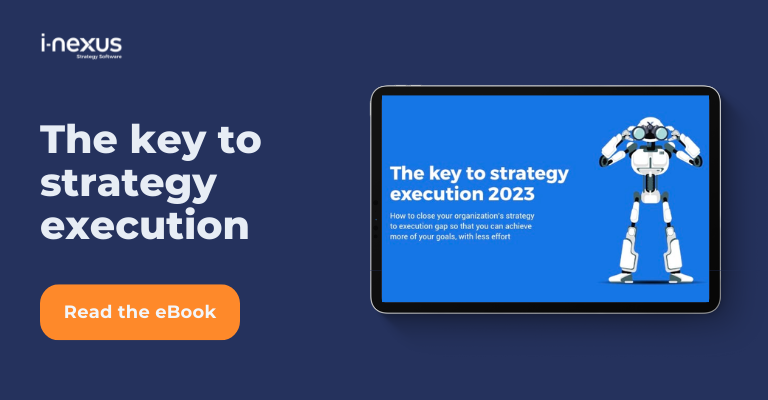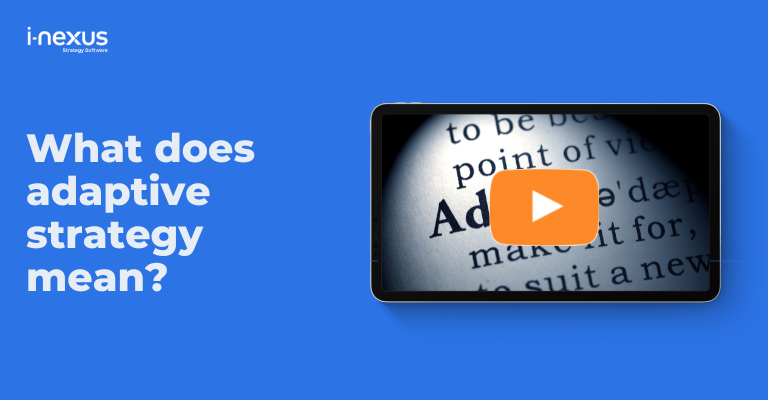Delivering strategy from plan to execution comes with great responsibilities and that calls for an even greater leader. Your CSO may captain the ship, but everyone has a role to play.
Written by: James Milsom, Head of Marketing
The oil tanker metaphor is synonymous with Strategy Execution Management, and for good reason.
It follows that asking your organization to change course is a tremendous ask of its people, processes, systems, and culture. To do so takes great resources and a leader who can inspire transformation across the entire business.
Much has been written about the complexity of Strategy Execution Management, but like being faced with treacherous sailing conditions, your organization requires effective leadership to guide you through the transformation that awaits you.
Captains make full use of their surroundings, experience, and crewmates to navigate from point A to point B. How they reach this destination is no small feat. Neither is a strategic leader achieving their breakthrough goals over a three-five year period.
Today we’re examining why strategic leaders must captain the ship of Strategy Execution.
From the role to be played and what great leadership looks like, to the common failings of leaders, we’ll set sail through the waters of strategic management, reaching the conclusion that greater leaders are the thread that keeps the organization together.
What is the role of leadership in Strategy Execution Management?
Planning and formulation
When planning and formulating a strategic direction, leaders will go into the process open-minded, knowing that their decisions will lead them to have to motivate and move their organization to work together towards a new, breakthrough level of performance.
Leaders must approach the conversation of strategic formulation with openness.
The point of the conversations at this stage is to ask what is truly important to our customers.
The team of key decision-makers will:
- Develop initial agreement over the strategic direction (points of impact).
- Craft and agree on the breakthrough objectives.
- Clarify the mission and values of the organization.
- Identify the external and internal factors impacting their intended strategic direction, paying particular attention to customers’ wants and needs.
- The strategy must align with the organization’s business policy and look on a three-five-year horizon.
- Define the future state of the business – where does the strategic leadership team want the business to be that destination point.
Implementation
At the implementation phase, a strategic leader must show that they are committed and involved in the process. Participation is mandatory.
The top-level leadership team must identify at lower levels the key department heads and other senior leaders that must be consulted and involved in the strategic implementation process.
The leader will be tasked with translating the vision, mission, and strategic objectives into breakthrough goals and improvement priorities. Therefore, enthusiasm and interest in wanting to learn new skills and achieve unparalleled success are needed.
They will be tasked with injecting energy and urgency into their teams around the improvement priorities and supporting initiatives that they will be contributing with.
Execution
The execution phase of strategic management is where the strategic leader must become the purveyor of all the initiatives with the strategic universe they have formed.
This is typically referred to as portfolio management. The leader will need to have systems in place to tell them about the utilization of resources, ROI of current projects, and completion rates, for starters.
Execution is the hardest phase in the Strategy Execution Management discipline.
Good strategic leaders will know which projects make up their portfolio.
Better ones will receive data-driven advice on which projects should be pushed, and those which should be thrown away.
Great leaders, however, will be able to reach their own conclusions from well-presented data, their own experience, as well as those internally, as to which portfolio items to perform kaizen events on to understand their performance levels, all the while being able to reconcile resource scarcity – a natural enemy of the strategist.
The leader is, indeed, the captain of the strategic ship. They are the thread that holds together the different initiatives and they have the presence and fortitude to clarify, inspire and re-direct the organization back towards its intended destination.
They absolutely must be able to identify early signs of underperformance or challenges to their plan and act swiftly.
What does a great strategic leader look like?
While not an exhaustive list, a great strategic leader will possess qualities such as these.
1) They're conscientious
The greatest strategic leaders are capable and mindful of the need to delegate, but they do so conscientiously, not overpowering or overwhelming the delegate.
2) Inquisitive and open-minded
They are inquisitive about the options available to the organizations to attain breakthrough performance and willing to seek roads less traveled.
This open-mindedness reaches into the realms of new processes, systems, and software to underpin their Strategy Execution Management. Whatever leverage can be made of new possibilities, they are open to this.
3) Honest, committed and transparent
Successful strategic leaders being with honesty and commitment as a standard.
They use this to show their passion for the plan, setting clear boundaries of the game and a playing field for change by mobilizing internal resources and external advice to set the best course of action.
4) Natural networker
They are open to networking internally, as well as across organizations and industries, making use of their influence to convince all stakeholders of the need for change and the direction set
5) Experience-based learner
Leaders should set out to be creators of experience-based learning opportunities.
Siloes between business units and functions are torn down, allowing creativity and knowledge sharing across once insurmountable boundaries.
6) Transformer
They hire and plan for transformation.
They know which resource is needed to support their breakthrough goals and do what is required to access this.
7) Reflective yet pragmatic
Reflection of performance through data-driven reviews is a standard, but their forward motion is based around a countermeasure culture, put action and pragmatism above decision-paralysis.
This pragmatism extends into their ability to help the organization.
They do not let fleeting desires of implementing Hoshin for every sub-level, for example, derail them from the critical few.
Whether the CEO or VP of Transformation, this strategic leader will ensure that clear objectives are set and processes agreed to measure and prove ROI of their plan.
8) Forward-thinking
They understand that leadership is an ongoing program of growth.
A leader does not simply exist one day and disappear the next.
They will put a concerted effort into being present in the lives of their leadership team to grow their skill set, all the while be approachable to the front-life staff.
What are the different types of strategic leaders?
With these traits in mind, we can begin to identify different types of strategic leaders:
1) The innovator
The strategic leader looks at the strategy in front of her as a way to take innovative steps to deliver value to the customer that is unprecedented in its form or impact.
This leader will look to every area of the business which can help with the breakthrough objectives and consider what can be done differently to provide an answer to the demands of the customer.
They have a clear eye on the competition, both within the direct and adjacent industries to theirs, and seeks to make the business innovate its process, products, and customer experiences.
2) The analyst
The analyst is typically from a product or marketing background.
They sit atop the corporate tree and within industry groups and at the government level, working to understand the market conditions which will impact their organization's three-five-year horizon.
They're adept at using tools such as the VRIO assessment to analyze the internal resource at their disposal.
They take this assessment and combine it with a breakdown of the value streams attached to their breakthrough objectives and improvement priorities.
This data will highlight the resources of the greatest value to them in executing their strategy, not simply the most readily available resource, a common failing of Strategy Execution Management.
A leader is ineffectual without organization.
Therefore, they will analyze their external and internal condition, setting sail with the right equipment, resource, crew, and course of direction to reach their destination.
3) The decision-maker
The decision-maker revels in the challenge of walking the tight rope of Strategy Execution Management.
With ample data at their disposal in the form of digital dashboards, trusted and empowered stakeholders from across the Enterprise Project Management Office, and leaders from within the three layers of their strategic plan, they put logic and data above narrative when making decisions.
Akin to the captain making use of their radar, sense of direction, and chief engineer, the strategic decision-maker makes the decisions they feel are best, with all available data, on which initiatives to push forward with, which to reallocate resources to, and the others which should be side-lined.
With their leadership qualities leaning towards decision making, their project portfolio management is exceptional.
What are the benefits of great strategic leadership?
From transparency to cohesiveness, these are some of the greatest benefits to be had from strategic leadership:
1) Transparent decision making
One of the challenges that persist throughout every organization is the proverbial water-cooler talk. Hearsay, gossip, or klatsch, it is the ever-present danger of business.
It is a challenge that strong leadership can go some way to containing.
The reason being that transparency of how decisions are made, and involvement through catchball techniques or OKRs, will help your business know the true motivators of your actions as a leader.
Furthermore, you can move forward knowing that the business knows what is asked of them and their role in reaching the well-defined destination.
2) Easier implementation
With clarity comes engagement and enthusiasm.
Your strategic implementation can fail or succeed based on your ability to motivate and mobilize your workforce.
If your organization knows of your vision and all that has colored your direction, objectives can be formed and aligned easier, and front-line staff knows that their work is absolutely contributing to the greater good.
3) Perspective shift
Siloed mentality can be pervasive in every organization, but a means to limiting its impact is through strong leadership.
Leaders play their part in tearing down these walls by showing their commitment to involving the entire business in success.
As the captain is responsible for every crew member’s safe harbor, so too is the leader to ensuring the entire business moves together.
This parity of treatment and transparency fuels a perspective shift.
No more will you be unaware of what all teams are doing, or will knowledge sit in pockets of the business.
Strong strategic leadership will break down barriers so teams can motivate and participate in each other’s work.
When we embark on a journey to learn a new skill, increase our muscle strength, or some other milestone, we do so knowing that there are things we must do once we have set goals.
Those ‘things we must do’ speak to the implementation phase of Strategy Execution Management.
Please do not believe that you can set a strategic direction and move straight to execution.
Strategic implementation is the lost art of shepherding resources, securing employee engagement, and ultimately laying out processes and systems to help you execute your strategy.
Without these in place, your strategy will fall into that 70% failure rate with great ease. Why? Because a strategy is simply a piece of paper. Implementation sees your strategy flow into the planning phase, ready for successful execution.
Ignore the importance of strategic implementation at your peril.
What are the common failings of strategic leaders?
And with the benefits in mind, these are the common failings that can befall strategic leadership:
1) Do as I say, not as I do
Asking the organization to do something you cannot enforce or you would not do yourself. Leading by example is an ingredient for success.
The captain of the ship should be seen to embrace and support in whatever way is needed.
2) Communication breakdown
Failing to communicate the plan, breakthrough goals and improvement priorities.
Without these effectively communicated, organizations cannot move forward in unison and clarity of purpose.
3) Siloed thinking
Not heeding warnings of cultural barriers which need to be overcome.
Ignorance of internal obstacles can prove costly for success, after all, if one member of the ship's crew breeds discontent, the ship's safety and ability to reach its destination will be greatly compromised.
4) Confusing daily management with breakthrough management
If your strategic plan sets out for nominal increases in performance, you're seeking improvements in daily activity.
A strategic plan seeks goals and performance which are, naturally, difficult to reach.
Do not confuse an open, kind, and embracing personality as a leader for setting goals that will push your organization.
5) Lack of awareness of modern engagement techniques
Indeed, the carrot and the stick do exist and have a place in leadership vernacular but consider the ever-changing workforce of your business.
The introduction of gamification, that being things such as real-time performance measurement, benchmarking and levels of performance to be achieved, are being employed to motivate behavioral change.
It can also be used to educate and inspire change, such as Deloitte's gamification of their leadership academy.
Are you ready to lead?
Through the course of today’s overview, we have shown the role that leadership plays in Strategy Execution Management, re-iterating that leaders must be in control of the strategic ship, using their unique skill set to motivate, mobilize and engage with the entire organization.
What will have become clear is that leadership is not an easy task, nor will every person possess the skills to be successful.
However, with the right captain at the helm of the ship, Strategy Execution Management can indeed be a success and you'll reap the benefits.
The only question left to ask - are you ready to lead?
Moving forward with Strategy Execution Management
Click here to visit our strategy execution knowledge hub, filled with content to support you in embracing the 'no normal' of strategy in the 2020s and beyond, or explore these recommendations:
- 8 challenges with adopting Hoshin Kanri: If you’re considering adopting the Hoshin Kanri methodology, be sure to read this overview of the common challenges you’ll face.
- 5 traits of continuous improvement leaders: Now you know what it takes to be a great strategic leader, do you have the right people in your organization to help you turn your breakthrough results into daily management? Find out.
- Download our Key to Strategy Execution eBook: Read how companies like Danaher and HP have mastered Strategy Execution Management and what you can learn from them.
About the author
James Milsom is Head of Marketing at i-nexus. James has wide-ranging experience in markets such as telecommunications, energy, education, and software.
As Head of Marketing, his drive is to raise awareness and understanding of the challenges facing enterprises in delivering strategic objectives and transformation amidst changing markets and the obstacles traditional tools and methods present leaders.
If you’d like to talk more about Strategy Execution, reach out to James on james.milsom@i-nexus.com or connect with him on LinkedIn for the latest insights.




